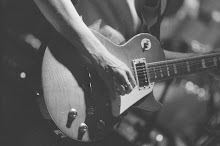In the world of Rock and Roll, simpler is often better. In the 1950s, what made Rock and Roll different from other popular music was both the small size of the band (often a trio) and the raw simplicity of the music. So it's no surprise that simple, but well made guitars and amplifiers have been a staple of the genre since almost day one.
The PRS SE One guitar at left is the perfect example of stripped down functionality at its best. It's based on the Gibson Les Paul Junior design which was originally made as a student guitar but caught on with many pro players from Leslie West to Billie Joe Armstrong.
The PRS SE One has a similar pedigree. The SE stands for Student Edition and boasts a relatively budget price. Don't let that fool you however - despite being half the cost of a similar Gibson, the PRS sports several design improvements. The lower cutaway is sculpted for easier access to the higher frets, while the back is slightly contoured to your body so it doesn't dig into your ribs.
Another difference is the scale. At 25 inches, it's a little longer than the Gibson which gives it slightly more string tension and a bit of a snappier sound. The action is also less rubbery if you prefer light strings such as .09s. It also has a wrapover bridge and a soapbar pickup which has that fat, toneful and slightly ragged sound that's typical of the design.
The neck is one of the most comfortable I have played and once you pick it up, it's hard to put down. But perhaps the thing I like most is what it doesn't have. Rather than separate volume and tone controls it only has one knob - volume. Like most electric guitars however, lowering the volume also bleeds off some of the treble so it's a tone control as well - plus it responds to the dynamic nature of your playing. Here's a short clip of me improvising some blues on it through a Fender Pro Jr. amp
In the darkness of a club if you want to adjust your volume or tone you have to quickly select one of as many as four knobs - not an easy feat when you're playing. With only one knob to worry about it's a lot easier to use. And there's good reason to use it. The volume knob gives you a host of options in a cranked amp. Set up a good distorted lead tone on 10, then roll the volume back to give yourself a nice crunch or clean sound.
Here's an example. In this short video I start off with the volume on 1, and do a near clean verse of Sweet Home Alabama. I notch it up to 5 for a great AC/DC sound, then up to 10 for some hairy, distorted Neil Young.
Contrast the SE One to this feature-full but mind boggling old Harmony below and you can imagine which is easier to change on the fly.

The PRS SE One is not only a great guitar for the money, it's a great guitar - period. While it's made in Asia to keep the price down, its playability ranks up with any professional guitar I've picked up.






No comments:
Post a Comment